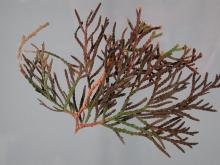Cause The absence of disease organisms, insects, or mites associated with this condition suggests the problem is due to stress of some sort. The exact source of stress that results in black flagging is unknown. Water stress, drying winds, high temperatures, injury to the roots, or damage to lower stems are possibilities. In some instances, black flagging has occurred when none of these conditions have been present.
This problem has been widely observed on arborvitae from all regions in Oregon, as well as from Washington, Idaho, and numerous other states across the country. Repeated incubations and isolations from affected tissue onto nutrient media, by multiple diagnosticians across the country, have consistently failed to produce any disease-causing microorganisms. The injury is not caused by insects mining in the foliage, nor is it due to girdling twig cankers. Sprays of insecticides and fungicides have no effect on reducing incidence of the discoloration.
Occasionally, the injury can be traced to chemical applications, which will be reflected in the spray pattern. For example, if the trees are growing as a hedge on the border between two properties, and only one side sprayed, then the injury will appear on only the sprayed side. Deicing salts (sodium chloride) can also damage foliage in areas where it is used on roads, driveways or parking lots.
The extreme heat in the PNW during the summer of 2021 caused extensive sunburn to many plants. Sunburn may result in similar symptoms and will be most extensive on the south or southwest side of plants.
Not to be confused with normal leaf browning and shed. Older inner leaves are normally shed in the fall over a long period of time. In some seasons, this normal leaf fall will occur over a shorter time period. Rapid changes in temperature in late winter or early spring have been reported to result in foliage browning. Spider mites and dog damage have also been a common problem on arborvitae.
Symptoms Only younger foliage is affected. Branch tips show a very dark-brown to black discoloration of the foliage-the color is not the brown associated with normal or disease-induced leaf senescence. This can occur on only one side, be evenly distributed over the entire plant, or occur only on some branches. Plants with black flagging are not permanently disfigured or injured. The condition does not always recur on an individual plant.
Cultural control Since this is not a disease or insect/mite problem, no pesticide applications are recommended.
- Prune the affected foliage to remove the unsightly tissue. Pruning allows more light in and stimulates growth of new foliage.
- Water regularly to the base of the plant during dry periods.
- Fertilize in spring to stimulate production of new foliage.
Reference Foster, A. C. and Maun, M. A. 1980. Effect of two relative humidities on foliar absorption of NaCl. Canadian Journal of Plant Science, 60:763-766.
Pirone, P. P. 1978. Diseases and Pests of Ornamental Plants, 5th ed. New York: John Wiley & Sons.

